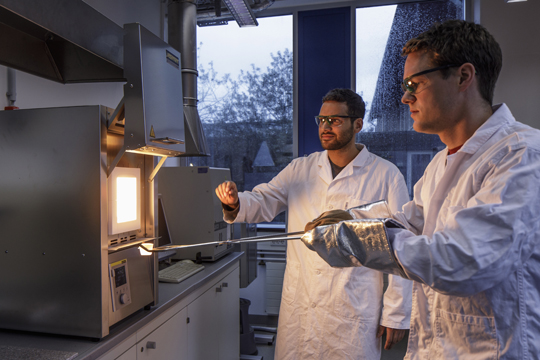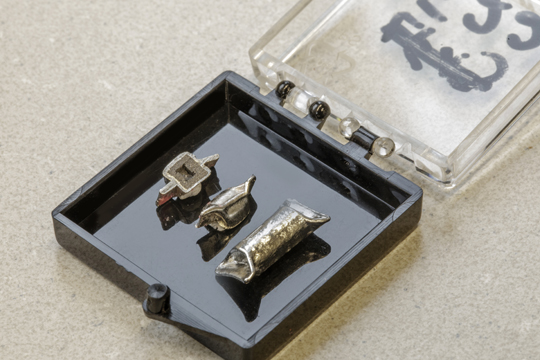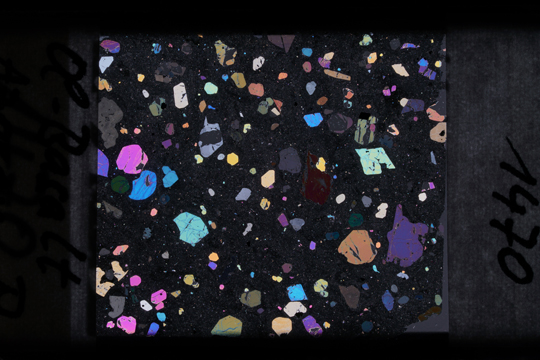Volcano in the Lab
Freiburg, Mar 09, 2020
Forestry, geology and environmental science research and teaching at the University of Freiburg have been independently organized for 50 years. To commemorate this anniversary, today’s Faculty of Environment and Natural Resources (UNR) introduces a range of research projects and departments in this occasional series of articles. Part one – “Rock” – looks at the work of Dr. Lennart A. Fischer of the Chair of Mineralogy and Petrology at the Institute of Earth and Environmental Sciences. With his experimental research on the creation of rocks he is not only finding answers to fundamental questions on the development of the Earth but also new approaches to calculating the risk of volcanic eruptions.
 1,600 degrees centigrade: using the high temperature kiln Lennart A. Fischer (right) can simulate the conditions in the Earth’s crust and in the interior of a volcano in his experiments. Photo: Jürgen Gocke
1,600 degrees centigrade: using the high temperature kiln Lennart A. Fischer (right) can simulate the conditions in the Earth’s crust and in the interior of a volcano in his experiments. Photo: Jürgen Gocke
Whether small and an unappealing gray, or large and with glittering crystals – stones have fascinated Lennart A. Fischer since he was a child. Since 2018 the geoscientist has been researching mineralogy at the UNR with a focus on experimental petrology, that is, the science of rocks. Fischer has been studying the question of how rocks are created from magma and lava in volcanic eruptions. Magma are hot, liquid rocky masses in the Earth’s interior, and lava is magma that is brought up to the Earth’s surface. The researcher usually works in a team with Freiburg colleagues and academics from other universities and research institutions.
In real terms, Fischer uses laboratory trials to analyze how changing parameters such as pressure, temperature or the viscosity of magma and lava affect the process of creation. “If water is frozen it turns to ice. The material is the same in chemical terms before and after the process,” explains Fischer. “This isn’t the case for stone, because mostly only parts of the molten rock crystallize.” Which crystals and types of rock are created depends on various factors. As well as the parameters already mentioned, this can include for example the time that passes as the mass arises from the magma chambers and during the cooling of the escaped flow of lava. This complex interaction of contributory factors determines whether magma turns into granite, basalt or andesite, for example, on its way to the Earth’s surface.
 The miniature magma chamber is used in the laboratory. In nature, such chambers lie kilometers below the Earth’s surface and can contain up to a million cubic kilometers of liquid rock. Photo: Jürgen Gocke
The miniature magma chamber is used in the laboratory. In nature, such chambers lie kilometers below the Earth’s surface and can contain up to a million cubic kilometers of liquid rock. Photo: Jürgen Gocke
Miniature magma chambers
In the last two years Fischer has set up two new laboratories at the institution. They are equipped with two high temperature kilns, a gas-mixture kiln, and a piston cylinder apparatus. With these he can create the ideal reconstruction of the conditions in the Earth’s crust and in the interior of a volcano in his experiments. In order to study how each of the parameters influences the path of the magma from below to above and thus also the formation of rock, Fischer constructs miniature magma chambers. In nature, these lie kilometers below the Earth’s surface and contain anything from a few cubic kilometers to a million cubic kilometers of liquid rock. The reproductions on the other hand consist of 100% platinum or gold, are one centimeter long and have a diameter of five millimeters.
Better calculation of risks
Fischer is planning to record the results of his research systematically and publish them in a specially-designed database. He hopes this will contribute to the optimization of models for the calculation of the risk from volcanoes. Until now, they have relied on equilibrium conditions in their calculations and have neglected dynamic experimental parameters such as Fischer studies. However the consequences of this procedure can be demonstrated by Fischer taking the example of crystal formation. Crystals appear in the liquid rocky mass when magma cools. Their dimensions and form depend on the dynamics and viscosity of the magmatic system. The speed with which magma rises to the surface in turn depends on the various pressure and temperature conditions. “If their rate of change slows down or speeds up, it affects crystal formation and thus the entire process,” says Fischer. “The more precise the risk calculation needs to be, the more these rates of change which can lead to an imbalance need to be incorporated in the models.” This would also enable better forecasting of whether a volcano will simply produce lava flows or erupt explosively.
 A section of basalt from Portugal: such colorful minerals have already been created in the magma chamber. The dark gray matrix consists of minuscule particles of crystal and glass which are created, for example, when the magma from a volcanic eruption cools rapidly.
A section of basalt from Portugal: such colorful minerals have already been created in the magma chamber. The dark gray matrix consists of minuscule particles of crystal and glass which are created, for example, when the magma from a volcanic eruption cools rapidly.
Photo: Lennart A. Fischer
Methods from industry
Lennart A. Fischer is sure that the database will benefit not only the scientific community that is engaged in vulcanology and petrology. For expert colleagues such as materials scientists from the glass and metal industries, the principle of the database and the fundamental results on melting, cooling and time/temperature rates could be important. Fischer knows well from his own experience that cooperation between scientific research and practical experience brings advantages to both sides. On a joint project with a partner from industry, he succeeded in transferring the oscillation method – which is used in the glass and steel industries – to issues of petrology. Using this new process he was able to expand the range of his experiments. “Until now I’d measured the viscosity of lava in trials using a rotating measuring cylinder. This process had the disadvantage that it can only be used for liquid rocks with a crystal content of less than 40 per cent. Because of the back-and-forth movement during the oscillation the viscosity of the material can even be measured with a crystal content of 100 per cent.”
Stimulating enthusiasm
Alongside his work in the laboratory and on site, since 2019 Fischer has been involved in the public Science Days and visits high schools on research days, to introduce boys and girls to mineralogy. This activity is funded by the Alexander Tutsek Foundation and the Deutsche Mineralogische Gesellschaft e.V. through the Germany-wide project “Der Mineralogische Lehrkoffer” (MiLeKo), which aims to raise the profile of this field. The target groups are school pupils from the fifth grade. “I explain to them the principles of mineralogy and talk to them about potential careers in this field. At the same time, using practical examples I show them how important stone is in everyday life and how many and varied are the ways it is used – whether for building houses and roads or in the form of metals in a mobile telephone,” says Fischer. He hopes this work will pass on some of his enthusiasm to the next generation.
Kristin Schwarz

